No-Knead Maple Oat Bread
This post may contain affiliate links. Please read my disclosure policy.
Sweetened with maple syrup and loaded with oats, this fresh maple oat bread is baked in a loaf pan, comes together in no time, and is so, so tasty. The oats give the bread a nice chew, and the whole wheat flour lends a heartiness, making it an excellent toasting bread.

One of the recipes from my cookbook, Bread Toast Crumbs, that trips people up the most is the oatmeal-maple loaf. It’s a simple no-knead recipe, just like all of the others in the book, but the process is slightly different, and the written format, as a result, is also different.
In short, in this recipe, the water gets added in two phases: first, the oats, maple syrup, and salt soak in 1 cup of boiling water for 10 minutes; then more water gets added along with the yeast and flour.
Because my publisher only includes water in the ingredient list if it is “boiling” or “lukewarm” or “ice cold”, etc., only the 1 cup of boiling water is listed in the ingredient list. You are instructed to add the remaining water at the end of step 1.
Many people over the years have missed this detail and have made the recipe using only 1 cup of water, and when their oatmeal-maple bread has baked into a doorstop, they’ve emailed me wondering why.
It always makes me sad, because I love this one so much — the oats give the bread such a nice chew, and the whole wheat flour lends a heartiness, making it an excellent toasting bread.
After sharing the recipe for the loaf pan peasant bread over on Cup of Jo, I thought it might be nice to revisit this one and re-write it for a single loaf pan, since most people have one, and include all of the water in the ingredient list to prevent the production of any more oatmeal-maple doorstops.
A Note on Whole Wheat Flour
The original recipe calls for a mix of whole wheat flour and white flour. In this recipe, rather than using commercial whole wheat flour, I’m using stone-milled flour from Cairnspring Mills. I’ve written about the benefit of using stone-milled flour in this post, the most compelling reason being that stone-milling preserves more of the bran and the germ, which is where many of the nutrients, antioxidants, oils, and flavors are stored. Industrial mills remove this germ in order to create a shelf-stable product.
As an experiment, I made one loaf with commercial bread flour exclusively and one loaf with a mix of commercial bread flour and stone-milled flour, and while they both were good, the one made with stone-milled flour was superior in both flavor and texture.
I find locally milled stone-milled flours at a local co-op, Honest Weight Food Co-op, and I also order online from various sources. Here are a few I love:
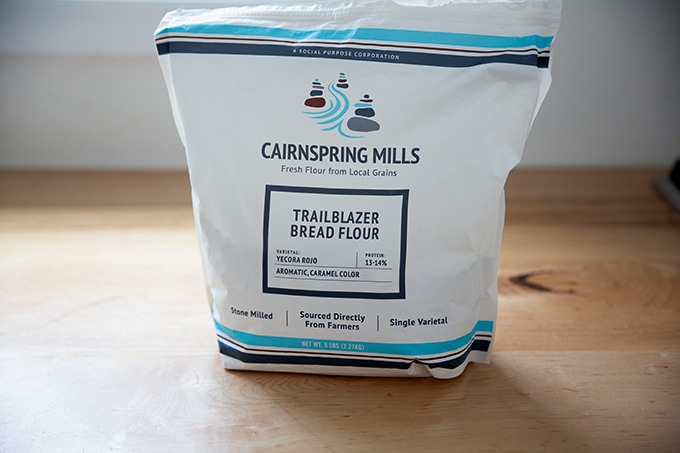
How to Make Oatmeal Maple Loaf, Step by Step
First, gather your ingredients: flour, salt, water, oatmeal, maple syrup, and instant yeast (SAF is my preference).

In a large bowl, combine the oats, salt, maple syrup, and 1 cup boiling water. Let stand for 10 minutes. Then add 3/4 cup cold (or room temperature) water.

Sprinkle the yeast over the top and stir to combine.

Add the flour or flours: I’m using a mix of 1 cup Trailblazer Bread Flour and 2.25 cups King Arthur Flour bread flour.
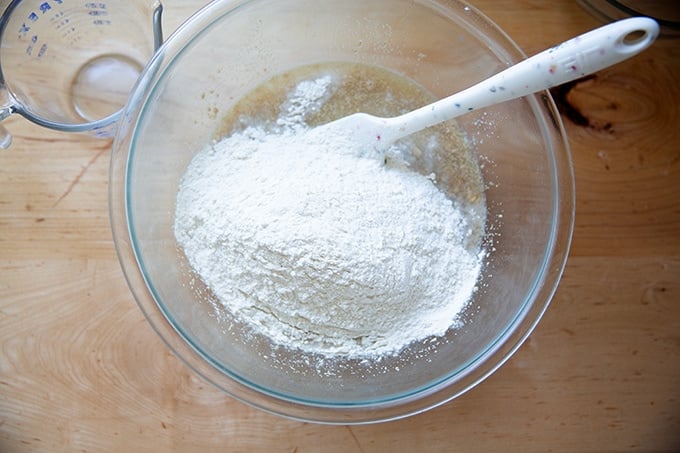
Mix until you have a sticky dough ball — you may need to knead with your hands to get the dough to come together into a ball.

Cover the bowl and let rise in a draft-free spot for 2 to 3 hours …

… or until doubled in volume:
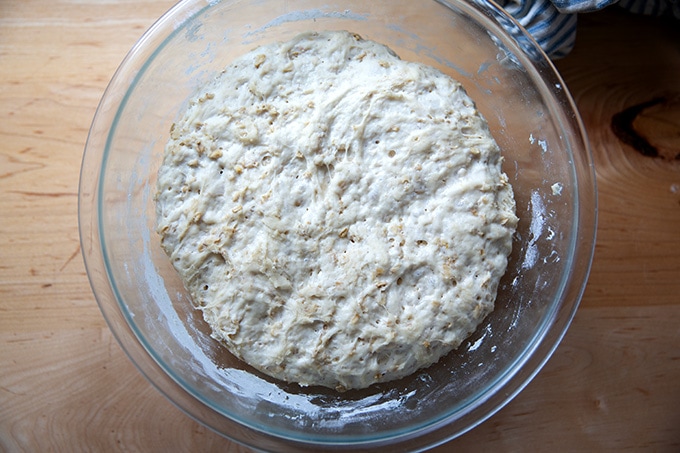
Once doubled, slick the surface with a little olive oil and release it from the sides of the bowl.

Turn the dough over, roll it into a coil or a loaf shape, and place it in a buttered loaf pan coated with oats.
Sprinkle oats over the surface of the dough as well. Let rise for another 45 minutes to an hour or …

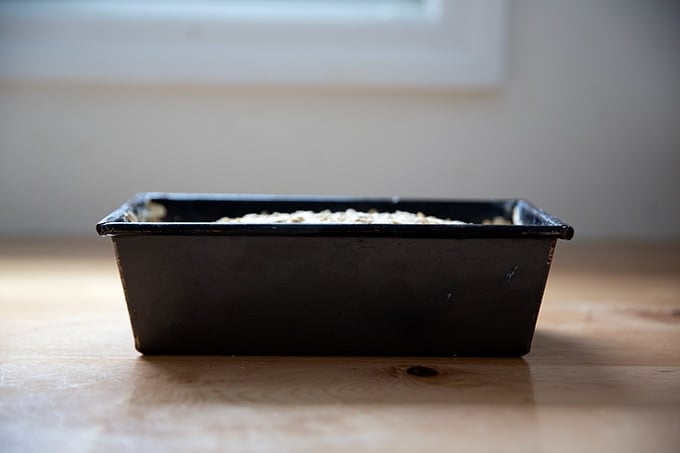
… until the dough has risen considerably. Transfer to the oven and bake for 45 minutes at 375ºF.


Let cool for at least 30 minutes before slicing.

This is a side-by-side comparison of a loaf made with all bread flour (on the right) and one made with a mix of stone-milled flour and bread flour (on the left). It’s a subtle difference but the loaf on the right is slightly loftier.
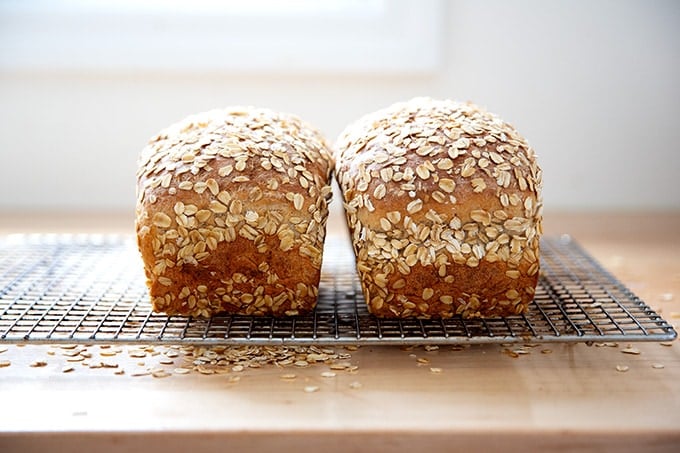
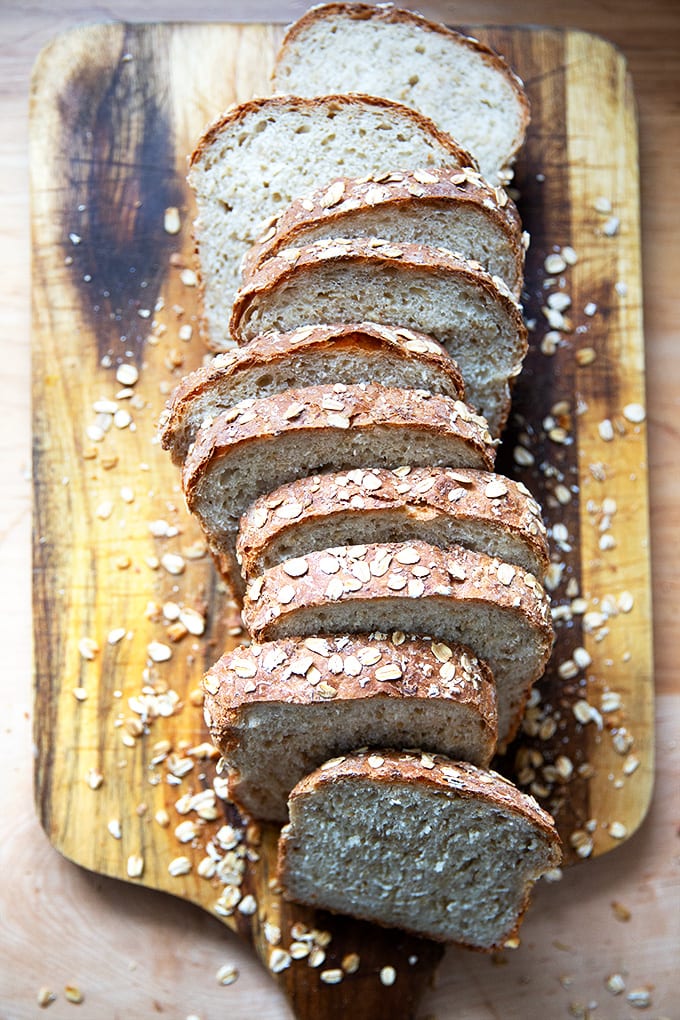
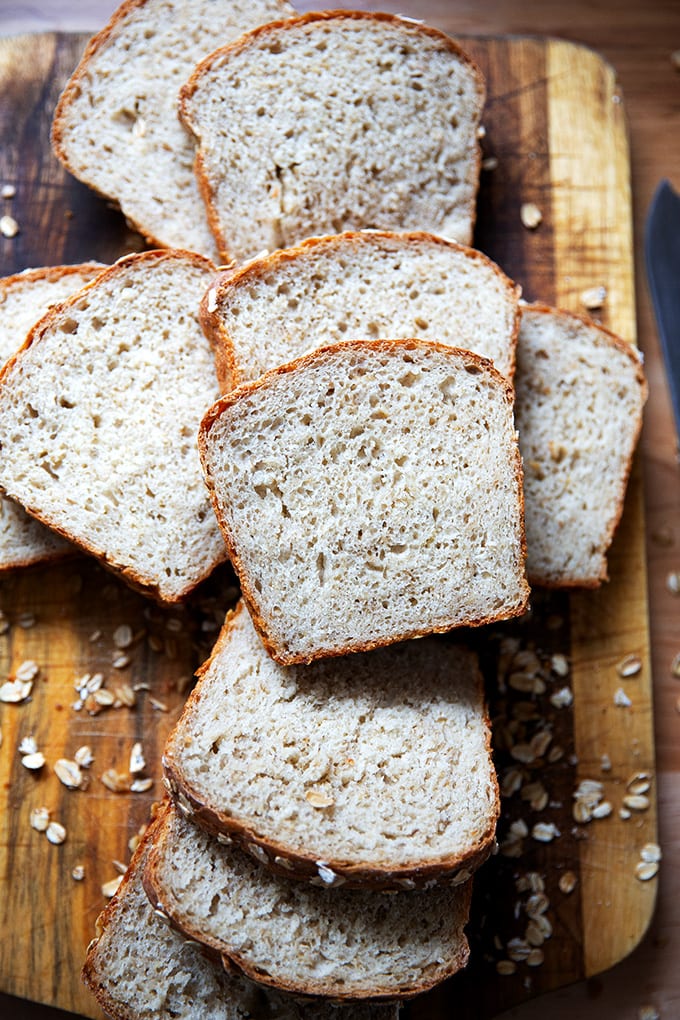
Toast and slather with butter.

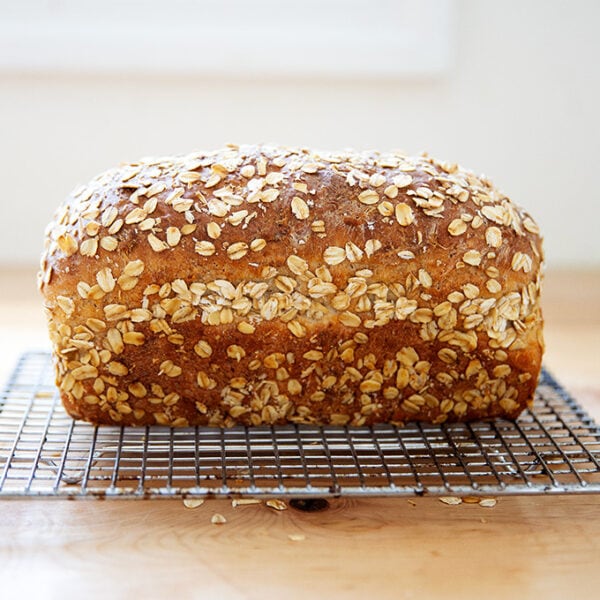
No-Knead Maple Oat Bread
- Total Time: 5 hours 45 minutes
- Yield: 1 loaf
- Diet: Vegan
Description
Sweetened with maple syrup and loaded with oats, this fresh maple oat bread is baked in a loaf pan, comes together in no time, and is so, so tasty. The oats give the bread a nice chew, and the whole wheat flour lends a heartiness, making it an excellent toasting bread.
Adapted from my cookbook, Bread Toast Crumbs.
Changes from the original recipe include:
- The vessel: This one is baked in a single loaf pan as opposed to two 1-quart Pyrex bowls. You can use an 8.5×4.5-inch pan or a 9×5-inch pan. I prefer the 8.5×4.5-inch pan for this one because it creates a slightly taller loaf.
- Flours: The original recipe calls for a mix of white and whole wheat flour. Rather than using commercial whole wheat flour, I’m using stone-milled flour, which is more nutritious and more flavorful. Read more about it here or up above in the post.
- Water: I’ve cut the water back by 1/4 cup because I was finding my finished loaf to be a little too damp for my liking. With this slightly smaller amount of water, the dough is a teensy bit stiffer and therefore requires a bit more time to rise.
If you like this recipe, find 40 variations in my cookbook:
Ingredients
- 1 cup (88 g) rolled oats plus another 1/2 cup (44 g) for coating the pan
- 1 cup (227 g) boiling water
- ¼ cup (86 g) maple syrup
- 1.5 teaspoons (5 g) kosher salt
- 3/4 cup (170 g) room-temperature water
- 1.5 teaspoons (5 g) instant yeast
- 2¼ cups (288 g) unbleached bread flour or all-purpose flour
- 1 cup (128 g) stone-milled flour or whole-wheat flour, see notes above
- Softened unsalted butter, for greasing
- 1 tablespoon olive oil
Instructions
- In a large bowl, combine the oats, boiling water, maple syrup, and salt. Let stand for 10 minutes. Add the remaining 3/4 cup (170 g) water and stir to combine. Add the instant yeast, and stir to combine. Finally, add the flours and stir with a rubber spatula, until the liquid is absorbed and the ingredients form a sticky dough ball. You may need to knead the dough with your hands briefly to help the dough come together, no more than 15 to 30 seconds.
- Cover the bowl with a tea towel or plastic wrap and set aside in a warm spot to rise for 2 to 3 hours, until the dough has doubled in volume.
- Preheat the oven to 375ºF. Grease an 8.5- x 4.5-inch (or 9×5-inch) loaf pan generously with softened butter. Pour the remaining 1/2 cup of oats into the loaf pan and turn the pan so that the oats coat the pan on all sides. Pour out the remaining oats and set aside.
- When the dough has doubled, drizzle the tablespoon of olive oil over the top and use your hand to rub the oil over the surface to coat. Use your hand again to release the dough from the sides of the bowl, then flip the ball over so that the oil side is down. Roll the dough into a coil or into a loaf shape (see video in the post above), then transfer to your prepared pan seam side down. Pour the reserved oats over the top, then spread with your hand or shake the pan to distribute them.
- Let the dough rise on the countertop (preferably in a warm, draft-free spot) for 45 minutes to an hour or until the dough has risen significantly in the pan — it should be doming above the rim of the pan by about one inch. See photos for reference.
- Transfer the pan to the oven and bake for 45 minutes, or until the top is evenly browned. Remove the pan from the oven and turn the loaf out onto a cooling rack. Let the loaf cool for at least 30 minutes before slicing.
- Prep Time: 5 hours
- Cook Time: 45 minutes
- Category: bread
- Method: oven
- Cuisine: American
This post may contain affiliate links. Please read my disclosure policy.

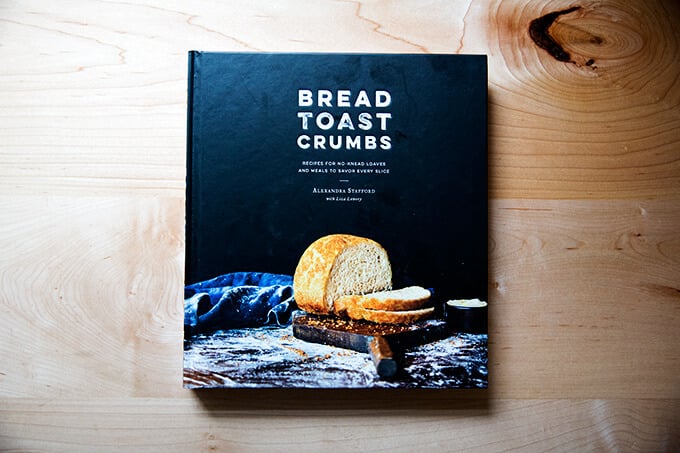










151 Comments on “No-Knead Maple Oat Bread”
This recipe is so quick and delicious! I live in WA and have started experimenting with Cairnspring Mills and other locally-milled flours.
I used their flour, just as you described and it turned out beautifully. In your experience, would you use all of their flours similarly? Meaning, using only a portion of the total flour called for like WW flour is usually incorporated? Or, could an entire recipe’s flour be made from their products (bread and/or AP flours)?
Thanks!
Laura
Great to hear, Laura! I recently made the peasant bread recipe with 100% Cairnspring Mills flour, and it was delicious, but definitely denser. I don’t mind because I use it primarily for toast, but the texture was dense for sure. You could do one of two things: try using 100% Cairnspring Mills flour the next time, then adjust accordingly the following time around given your results, or you could try upping the proportion of Cairnspring Mills the next time you bake, and again adjusting with more the following time around given your results. In sum: it works and will be tasty, but the texture will be denser 🙂
Hey Alexandra! Is there a way to substitute a portion of sourdough starter for the dry yeast? I imagine it would definitely change the rise times but I don’t like to use instant yeast I’ve substituted sourdough starter when making rye bread usually use anywhere from 50 to 150 g and I’ve had pretty good success. Thanks!
Yes, go for it! I usually use 100 grams starter; then I use 50 grams less flour and water to compensate. Would love to know how it turns out if you give it a go. Good luck 🙂
Hey Ali! Quick question: in the book it says it makes two loaves, but for this one it says only one and the measurements are the same. Which one is correct? Thanks!
Hi! This is an updated recipe/adapted recipe from the book… read the start of the post and it explains why — in sum, they are both accurate, but this one is less confusing 🙂 🙂 🙂
I’ve successfully and joyfully made your peasant bread many many times! I’ve tried this maple oat bread twice, once using the recipe on your website (loaf pan) and once from the cookbook (2 bowls) Both didn’t rise well and were tough.
Are you using a scale to measure? What type of flour are you using? When you made the recipe from the book, did you add the cup of water that is included in step 1 of the recipe but that is not actually listed in the ingredient list?
I’ve made this with sourdough, and it was a success, so I thought I’d share:
88g rolled oats, 225g boiled water, 86g maple syrup, 1.5tsp salt, let rest, then added 120g water, and 100g starter. After mixing these I added 100g wheat flour, 266 bread flour, 1 Tbsp olive oil.
I did an overnight counter ferment, for 12+ hours which I think was a touch too long. The dough was very loose, so I did not handle it much except to make a rectangle and roll it up into the pan shape. I let it rise in a warming oven (45C) and it was ready to go after an hour.
Given all that, I was very surprised that this turned out well, but it was very lovely with a nice tight crumb and soft thin crust. I will make this again but shorten the fermentation time.
Thanks!
Wonderful!! Thank you so much for sharing this, Meredith — so helpful for others 🙂
Hello, my dough seems more wet than what I see in the video, should I reduce the water? I felt this happened when I made the Focaccia bread too. Do you have a recipe for Semolina bread? I really like your bread making method.
Hi and thank you 🙂
Yes, probably reduce the water slightly.
Are you using a scale to measure?
I have a rosemary-semolina bread recipe in my cookbook, Bread Toast Crumbs.
Can you bake this in a cadt iron enamel dutch oven?
Yes, but keep the baking temperature the same — in other words, don’t preheat the Dutch oven to make a crusty boule… this bread will burn due to the maple syrup.
I’ve made this recipe twice this week, and will be making it again soon, especially considering how quickly one can make this bread. I make boules all the time, but it’s so nice to just make a regular sandwich loaf too. It’s just the perfect amount of sweetness, not too sweet, just enough, and a beautiful crumb considering how much whole grain is in the recipe. Absolutely worth a try.
Great to hear, Kristin! Thanks so much for writing and sharing this 🙂
In order to make it dairy free can I use oil instead of butter for greasing a loaf pan?
Thanks in advance!
That should work! I worry a little about sticking. What material is your pan?